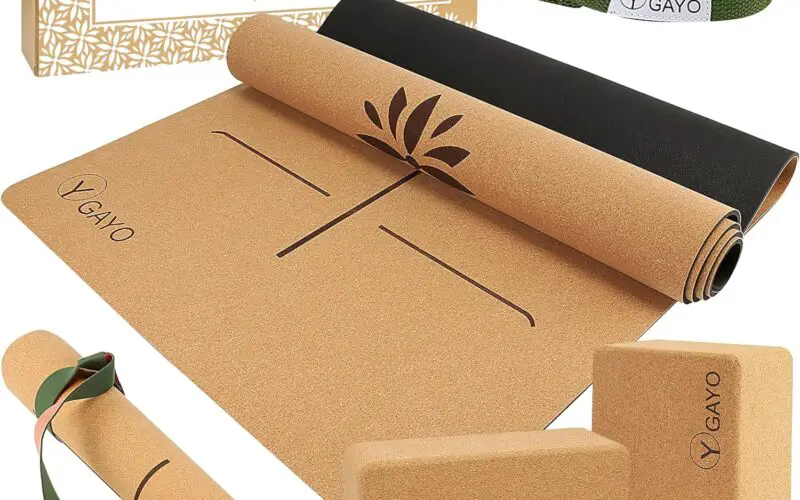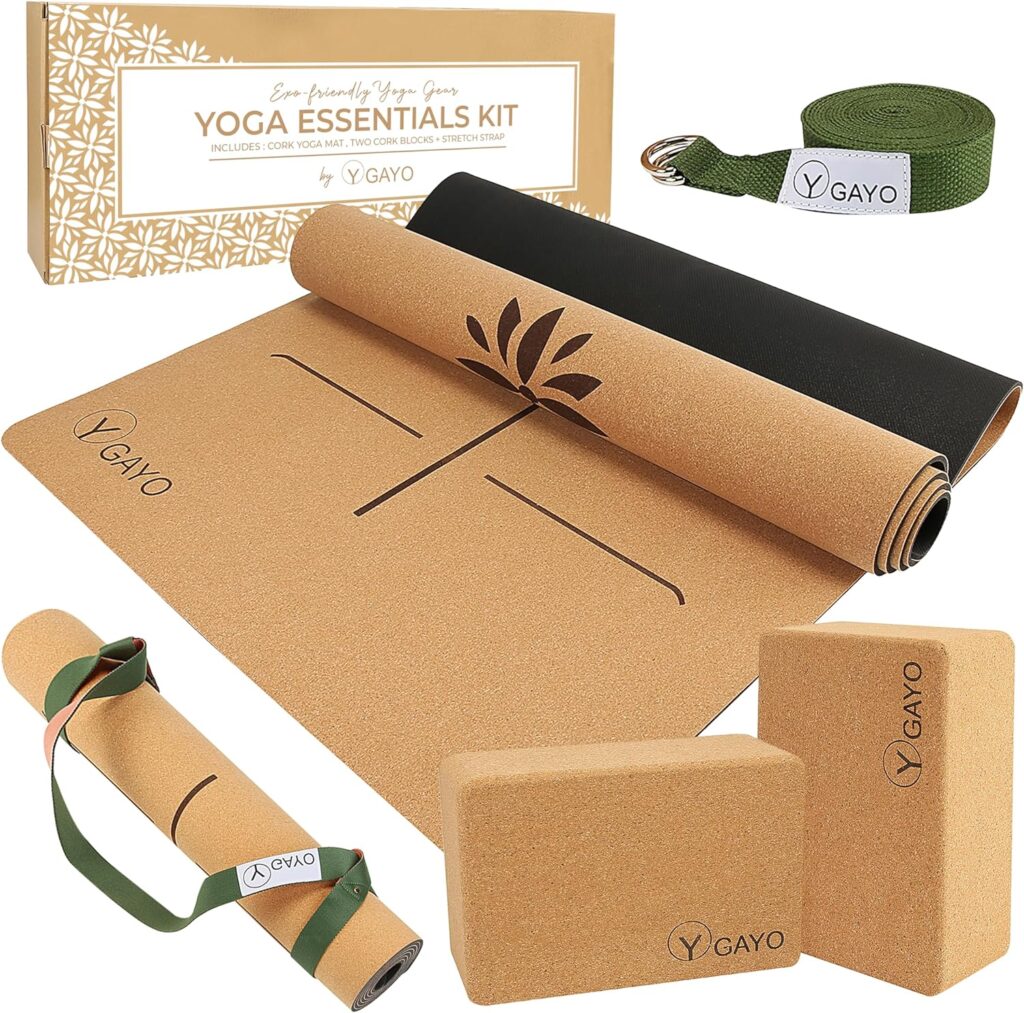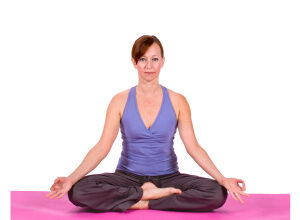Table of Contents Show
A successful yoga session starts with selecting the perfect mat. Choosing between a TPE and PVC yoga mat, however, can be complex. This article presents a detailed comparison between the two, aiming to simplify your decision-making process. Continue reading to gain insight and decide on the ideal mat for you. Factors such as comfort, durability, health considerations, and environmental impact of TPE and PVC mats will be examined. This guide aims to assist you in making an informed choice.
When it comes to choosing the perfect yoga mat, the debate of “tpe vs pvc yoga mat” often comes up. But which one is truly the best? To answer that question, we’ve put together a comprehensive, engaging, and informative article that will not only help you understand the differences between these two materials but also guide you in making the right choice for your yoga practice. So, grab a cup of tea and settle in for the ultimate showdown!
Disclosure: As an Amazon Associate I earn from qualifying purchases.
What is TPE yoga mat?
A TPE yoga mat, or Thermoplastic Elastomer yoga mat, is a type of yoga mat made from a blend of recyclable and eco-friendly materials. TPE is a synthetic compound that combines the characteristics of plastic and rubber, resulting in a mat that is non-toxic, lightweight, and provides excellent cushioning and resilience. TPE yoga mats are known for being free from harmful chemicals like PVC, latex, and harmful phthalates, making them a popular choice for environmentally conscious yogis.
What is PVC yoga mat?
A PVC yoga mat is a yoga mat made from Polyvinyl Chloride, a synthetic plastic material. These mats are known for their durability, affordability, and water-resistant properties. However, it’s important to note that PVC is not environmentally friendly and may contain harmful chemicals, so users often consider alternative, more sustainable options like natural rubber or cork mats.
Battle of the Materials: What Exactly are TPE and PVC?
Before diving into the great TPE vs PVC yoga mat debate, let’s understand the materials involved.
Thermoplastic Elastomer (TPE):
- TPE is a blend of plastic and rubber.
- It’s eco-friendly, biodegradable, and recyclable.
- TPE is soft, lightweight, and offers excellent cushioning.
Polyvinyl Chloride (PVC):
- PVC is a synthetic material made from vinyl and plastic.
- It’s durable, affordable, and offers excellent grip.
- However, PVC is not eco-friendly and may contain harmful chemicals.
Round 1: Comfort and Cushioning
When it comes to comfort, you want a mat that provides the perfect balance between cushioning and support. How do TPE and PVC yoga mats fare in this round?
TPE Yoga Mats:
- TPE mats are known for their softness and excellent cushioning.
- They provide great support for joints during practice.
- TPE’s closed-cell structure prevents moisture absorption, making it easy to clean.
PVC Yoga Mats:
- PVC mats are firmer than TPE mats, providing a more stable surface.
- They offer excellent support for balancing poses.
- PVC mats can be slippery when new, but they develop a better grip over time.
Round 1 Winner: TPE (if you prefer softness and cushioning) or PVC (if you need more support and stability).
Round 2: Durability and Lifespan
A long-lasting mat is a wise investment. But which material, TPE or PVC, will outlast the other in your yoga journey?
TPE Yoga Mats:
- TPE mats are less durable than PVC mats due to their softness.
- They can wear out faster, especially with rigorous practice.
- TPE mats are sensitive to heat and sunlight, which can shorten their lifespan.
PVC Yoga Mats:
- PVC mats are known for their exceptional durability.
- They can withstand daily use and resist wear and tear.
- PVC mats can last for years with proper care.
Round 2 Winner: PVC (for its unbeatable durability and lifespan).
Round 3: Eco-friendliness and Health Concerns
Yoga promotes mindfulness and respect for the environment. In the battle of TPE vs PVC yoga mats, which material aligns with these values?
TPE Yoga Mats:
- TPE is biodegradable, recyclable, and eco-friendly.
- It’s free from harmful chemicals like phthalates, latex, and BPA.
- TPE mats are a great choice for those with allergies or sensitivities.
PVC Yoga Mats:
- PVC is not eco-friendly and can take centuries to decompose.
- It may contain harmful chemicals like phthalates, which can be released over time.
- PVC mats can cause allergic reactions in some individuals.
Round 3 Winner: TPE (for its eco-friendliness and health-conscious properties).
The Final Verdict: TPE vs PVC Yoga Mat?
The ultimate decision between a TPE and PVC yoga mat depends on your personal preferences and priorities. Here’s a quick recap:
- Choose a TPE yoga mat if you value comfort, cushioning, and eco-friendliness.
- Opt for a PVC yoga mat if you prioritize durability, stability, and affordability.
- Remember, your yoga practice is unique, and the perfect mat for you may not be the same as someone else’s. Consider your specific needs and preferences, and choose a mat that supports your practice and aligns with your values.
Conclusion
In the epic showdown of TPE vs PVC yoga mats, there’s no clear-cut winner. Both materials have their strengths and weaknesses, and the right choice for you depends on your priorities and preferences. Consider factors such as comfort, durability, and eco-friendliness when making your decision, and choose a mat that will support your practice for years to come.
Happy yoga-ing!
You May Also Like: TPE vs. NBR Yoga Mat Showdown: 5 Powerful Differences You Must Know!
Frequently Asked Questions (FAQs)
1. Can I use both TPE and PVC yoga mats for hot yoga?
TPE yoga mats are not ideal for hot yoga due to their sensitivity to heat, which can cause them to degrade quickly. PVC yoga mats, on the other hand, are suitable for hot yoga as they can withstand high temperatures and provide excellent grip when wet.
2. How do I clean and maintain my TPE vs PVC yoga mat?
For TPE yoga mats, use a gentle cleaner or a mixture of water and mild soap. Wipe the mat down with a soft cloth, then rinse it with water and allow it to air dry. Avoid using harsh chemicals or exposing your TPE mat to direct sunlight.
For PVC yoga mats, you can use mild soap and water solution to clean the surface. Rinse the mat thoroughly and allow it to air dry. To maintain its grip, avoid using oils or lotions on your PVC mat.
3. How much should I expect to spend on a PVC or TPE yoga mat?
The cost of a TPE or PVC yoga mat varies depending on the brand and quality. TPE yoga mats typically range from $30 to $100, while PVC yoga mats can range from $20 to $120. Keep in mind that investing in a high-quality mat can save you money in the long run, as it will last longer and provide better support for your practice.
4. Are there any other eco-friendly alternatives to TPE and PVC yoga mats?
Yes, there are several other eco-friendly yoga mat options available. Some popular alternatives include:
- Natural rubber yoga mats: These mats are made from sustainably harvested rubber and offer excellent grip, cushioning, and durability. However, they may not be suitable for those with latex allergies.
- Cork yoga mats: Made from the bark of cork oak trees, these mats are sustainable, naturally antimicrobial, and provide great grip. They can be more expensive than TPE or PVC mats and may not offer the same level of cushioning.
- Jute yoga mats: These mats are made from natural jute fibers and offer a rough, textured surface for grip. Jute mats are eco-friendly and biodegradable but may not provide the same level of comfort and cushioning as TPE or PVC mats.






Comments are closed.